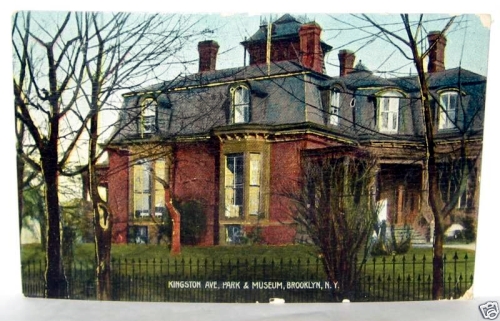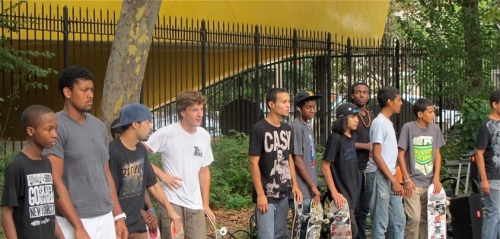Walkabout: Brooklyn's Small Parks: Brower Park, Part 2
Read Part 1 of this story. In 1892, the City of Brooklyn established Bedford Park, one of a group of city parks commissioned that year, to provide enjoyment, nature and fresh air to the people of Brooklyn. Please see Part One, for more on the philosophy of city parks in Brooklyn. Some of the parks…

Read Part 1 of this story.
In 1892, the City of Brooklyn established Bedford Park, one of a group of city parks commissioned that year, to provide enjoyment, nature and fresh air to the people of Brooklyn. Please see Part One, for more on the philosophy of city parks in Brooklyn. Some of the parks were much bigger, like Sunset Park, but Bedford Park was special; in part because of its unique features, and partly because it was a favorite of the Parks Commissioner, George V. Brower.
The park was situated on the square block bordered by Park and Prospect Places, and Brooklyn and Kingston Avenues, in the part of Bedford known as the St. Marks District. Just adjacent to the parkland, on St. Marks Avenue, were at least two estates, remnants of this area’s early development, when large country villas stood on substantial plots, the homes of some of Brooklyn’s most successful people. One such villa belonged to William Newton Adams, a wealthy banker and stock broker.
By the time Commissioner Brower was establishing the park, the Adams house had been turned into a sanitarium. Brower was hoping to demolish it, and extend the park to St. Marks Avenue, but the city decided to lease the house to the Brooklyn Institute of Arts and Science, which was building their huge new home on Eastern Parkway. This precursor of the Brooklyn Museum took over the Adams house, and put five of their scientific departments there, and in 1894, installed a public library in the house as well. It looked as if they were there to stay.
And it ended up being a great thing for the park, as the Institute’s lectures and exhibits were very popular, and brought people to the park from near and far. Bedford Park soon had an admirable reputation as one of Brooklyn’s best parks. People admired its rolling topography, the old growth trees and shrubs, with paths winding amongst them, and the natural, non-landscaped quality of the park. The park was an absolute success, with the Parks Department declaring in 1894. “It is now one of the prettiest small parks in the City.”
George V. Brower was Parks Commissioner for two separate terms; the first time in office was from 1889 to 1894. He came back in 1898, and served until 1891. He was from an old Brooklyn family, and was a very successful attorney. He was active in Brooklyn charities and concerns, and championed educational and public transit issues, and was a Democrat, which was unusual for most of the movers and shakers of the time. One has to wonder if parks were a particular concern for him before he became Commissioner, but sometimes the job finds you, and he would become one of the best Parks Commissioners in Brooklyn’s history.
Under his watch, the city built Sunset Park, Red Hook, Fort Hamilton, and other important parks in Brooklyn. He was an ardent champion for funding and keeping parks on the city budget. He also loved Bedford Park so much that he built his own home on the edge of the park, on the southeastern corner of Park Place and Kingston Avenue, at 1084 Park. He built a large house next door for his daughter, at 1094 Park Place, a large, eclectic Queen Anne house with Craftsman details.
In 1899, the Brooklyn Institute of Arts and Science voted to turn the Adams mansion into the country’s first Children’s Museum. In a radical change of pace, children would be encouraged to touch the exhibits, take part in workshop projects, and learn about the vast collections the Institute had, by experiencing exhibits, demonstrations and specimens mounted just for them, in a child-friendly atmosphere. There were even field trips. Considering that people during this time mostly thought of children as small adults, this approach was revolutionary. The Children’s Museum was a hit.
The park, with its elegant low cast iron fence surrounding it, continued to be quite popular. By the end of the first decade of the 20th century, St. Marks Avenue, just next door, was home to some of Brooklyn’s wealthiest people, including the Straus family, of Abraham & Straus, and Clarence W. Seamans, owner of the largest office machines company in America. In 1905, a handsome classically designed comfort station was built on the Prospect Avenue side of the park, and later, in 1919, a World War One memorial was erected to honor Brooklyn’s War dead.
George Brower died in his house at the edge of his beloved park, at the age of 81, in 1921. His children sold his home, and in 1923, it was torn down, and Congregation Shaare Zedek built a magnificent synagogue on the site. It was designed by Simon Eisendrath and B. Horowitz, the same architects who designed Temple Beth Elohim in Park Slope. George Brower’s daughter’s house still stands next door.
In 1923, the park property was extended to include the block between St. Marks Avenue and Prospect Avenue. This was the land that the Children’s Museum stood on, as well as other houses. Prospect Place, still an active street, divided the park into two sections. The Board of Aldermen also voted to change the name of the park to Brower Park, to honor the late George Brower. By this time, the Children’s Museum had outgrown the Adams house, and had spread to include the L.C. Smith house, next door, as well. The park was still growing.
In 1936, the Parks Department reconfigured the park, laying out the present day pathways, benches, water fountain and playgrounds. In 1947, the last bit of land between St. Marks Avenue and Prospect was added to the park. Some of that was taken by the George V. Brower Elementary School, which opened in 1958. That same year, the block of Prospect Place that ran through the park was decommissioned and grassed in, with only a pathway marking its place. New playgrounds and handball courts were built, as well.
By 1967, the Children’s Museum could no longer operate in the old Victorian mansions. Both houses were over one hundred years old, and not functioning well in the modern age. The museum was relocated to an old automobile showroom in Bedford Stuyvesant for ten years, as the old houses were torn down, and a new Children’s Museum built. When it re-opened in 1977, the Hardy Holtzman Pfeiffer designed building was hailed as an innovative and imaginative museum just for children. One entered on the corner of St. Marks and Brooklyn Avenue, and the entire museum was underground, with roof gardens and an amphitheater that integrated with the topography of the park itself.
This museum would anchor the park for the next thirty years. Like most of New York City’s parks, in the turbulent decades of the late 20th century, Brower Park would be ignored by city budgets and officials, and gain a reputation for being dangerous, and home to addicts, criminals, and drug dealers. There was certainly some truth in that, but the presence of the Children’s Museum was one of the reasons the park survived relatively intact. People from all over Brooklyn continued to bring their children to this unique and popular museum.
By the time the 21st century rolled around, the community wanted their park back. In 2002, architect Rafael Viñoly unveiled his controversial new design for a new and larger Children’s Museum. The large yellow two story structure, sheathed in millions of bright yellow ceramic tiles, would double the size of the museum, and enclose the 1977 underground structure in a new building, with new exhibit space, offices and amenities. It would be New York City’s first “green” museum, receiving a LEED silver rating. The new museum opened with great fanfare in 2008. It’s more popular than ever.
And so is the park itself. Things had greatly improved since the ’90s, but the park still needed some care. Neighbors gathered together to clean up the park, volunteering to aid an understaffed grounds crew with garbage pickup. One neighbor, Phil Hawkins, who lived nearby, gathered a group together that officially became the Friends of Brower Park in 2009. This grassroots organization has single-handedly turned the park around in the last three years. With the help of Eric Green, a local Parks Dept. retiree, the group took on the various tasks that needed doing in the park, and in the process, learned how to deal with the city, the Parks Dept., and the community.
They gathered volunteers to plant tulips and other flowers near the park’s entrances, something that has become a bi-annual event, now part of the “It’s My Park” program. Grants and sponsorships were sought, which brought volunteers from major Manhattan companies to the park to help clean up, paint and plant. In 2010, the Friends of Brower Park sponsored the first Brower Park Christmas Tree lighting ceremony, which has become an annual tradition in Crown Heights North, with kids and adults participating in decorating the tree, singing carols and enjoying refreshments.
Other programs have included free performances of Shakespeare, music and dance events, and the presence of a real piano, which is available for playing. A visit to today’s Brower Park will allow you to see children of all races, ethnic groups and religions playing together, tai chi classes on the hillside, a senior citizen exercise class, a brand new skateboard run, people playing with their dogs, runners circling the park, and people sitting on the repaired benches, talking, reading and doing what people do in every other park in the city: enjoying the day. It’s not perfect yet; it’s a New York City park, but I think George Brower would be proud of his favorite little park. Its best days are yet to come. GMAP
(Above photo: Bridge And Tunnel Club)







Related Stories
Walkabout: Brooklyn’s Small Parks: St John’s Park
Walkabout: Brooklyn’s Small Parks: Tompkins Park, Pt 1
Walkabout: Brooklyn’s Small Parks: Tompkins Park, Pt 2
Walkabout: Brooklyn’s Small Parks: Saratoga Park





Minard- you must come visit troy. You will love the architecture!
Love Brower Park, and having been in the daughter’s mansion, all I can say is…..drool.
Hi Minard1 and thank you, btw for the lovely comment in the book 🙂